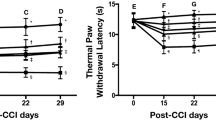Abstract.
The analgesic effects of high-energy extracorporeal shock wave therapy (ESWT) were discovered by chance during its application for urolithiasis and for bone pseudarthrosis. Despite the extensive use of ESWT, the mechanisms of its antinociceptive effects are still unclear. A gate control mechanism and other antinociceptive mechanisms have been postulated. The aim of this study was to investigate the possible influence of low-energy ESWT on the expression of the transmitters substance P (SP) and calcitonin gene-related peptide (CGRP) in the lumbar spinal cord of the rat. Immunohistochemical analysis of the expression of the neuropeptides CGRP and SP was performed in rats treated either once with 1000 impulses or three times with 1000 impulses, with two different energy flux densities being used (0.043 and 0.11 mJ/mm2). The animals were killed either 4 or 72 h after the ESWT. No regulatory effect of ESWT on the expression of SP or CGRP in the dorsal horns was found. Because the application of ESWT showed no significant changes in the sensory system, it is unlikely that the application of ESWT triggers the endogenous pain control system of the rat through hyperstimulation analgesia. Furthermore, these results show that low-energy ESWT had no side effects on the rat spinal cord.
Similar content being viewed by others
Author information
Authors and Affiliations
Additional information
Received: January 9, 2001 / Accepted: August 25, 2001
About this article
Cite this article
Haake, M., Thon, A. & Bette, M. No influence of low-energy extracorporeal shock wave therapy (ESWT) on spinal nociceptive systems. J Orthop Sci 7, 97–101 (2002). https://doi.org/10.1007/s776-002-8429-0
Issue Date:
DOI: https://doi.org/10.1007/s776-002-8429-0




